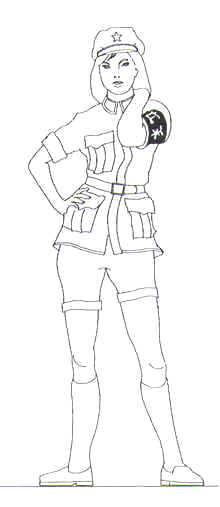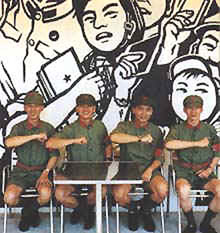| RESTAURANT REVOLUTION | |
 |
|
|
|
|
HOUSE
OF MAO II:
Oct
| Nov 1998 House of Mao II depicts the mood of an evening rally at Tiananmen Square. Giant posters of Chairman Mao waving at the crowd and that of enthusiastic school children waving back are executed by Willy Baet of Poole Associates. The color scheme, flags, lanterns and specially programmed lighting all reinforce the rally theme Signature elements of the original House of Mao such as the bar stools are used to maintain continuity between the two outlets Custom designed cabinets replicating those found in friendship stores in Shanghai are used to house the Mao artifacts of Dr. Yeo Seen Huat. The cabinets also function as a privacy screen between the restaurant and the corridor. Mao wrist watches are available - the hands move counterclockwise ! Click images for larger view photography : Peter Mealin
|
THE RED BOOK
G R E A T L E A P F O R W A R D Even before the dust has settled on the original House of Mao at China Square, Tung Lok president, Andrew Tjioe, has opened a branch at the Orchard Hotel Shopping Arcade. The newest addition to the gourmet dining group, House of Mao II, duplicates the success of the theme restaurant albeit in a slightly different form. While the original restaurant recreates the mood of a banquet at the Great Hall, Mao II depicts the mood of a rally at Tiananmen Square in the evening. Interior designer, Ed Poole from Poole Associates, has managed to replicate the feel of the first outlet through design details such as retaining the signature elements of House of Mao such as the stools at the bar counter. The most prominent item in the 2,180 square feet space is the giant portrait of Chairman Mao Zedong smiling and waving to the crowd. This is complimented by a delightful painting of Chinese school children waving back with their little red books. Both airbrushed works were executed by Willy Baet from Poole Associates. The giant portraits are complimented by almost 200 pictures of Chairman Mao which adorn the walls. As befitting the rally theme, the main wall posters revolve around speech-giving and crowd scenes. Reinforcing the Mao concept are 200 porcelain pieces and other memorabilia which are on loan from Dr. Yeo Seen Huat, an avid Mao collector. Television sets located at the bar and dining areas show video clips from the life of Mao, creating an interactive backdrop. Poole says that the design intention for Mao II was to create a more active and vibrant feel as befitting the mood of a rally. To do this, he has taken advantage of the high ceiling which is painted blue to depict the night sky while bright yellow walls provide contrast. An important aspect of rallies are flags so these have been faithfully added at strategic locations. Also included are Chinese lanterns which give the sense of an outdoor setting. Lighting-wise, spotlights have been strategically placed to focus on the tables only and as the light is not diffused, there is the feel of darkness, i.e. evening. To maintain the active feel, the "intelligent" lights are programmed to pan the crowd. Last but not least, there are neon signs which are a typical element of rallies in Tiananmen Square. "Mao II may appear different from the first restaurant initially because the layout is one big room as opposed to a z-shaped space," said Poole. But like its predecessor, it relates to the neighborhood and this design is more suitable for a street side restaurant along Orchard Road than one in Chinatown. Other design elements that contribute to the theme are a series of display cabinets flanking one wall of the restaurant. These are modeled after the cabinets in the traditional friendship stores in Shanghai. While serving as display areas for the Mao artifacts, the cabinets also act as a divider from the corridor outside, thus giving a sense of privacy to diners. Adding to the atmosphere is the piped-in music which was specially created by blending Chinese and Italian melodies. However stunning the decor, the main draw for any restaurant is still the food. Here at House of Mao II, the menu is an adventurous blend of east and west features the eclectic Hunan-inspired cuisine of Chef Susur Lee. While there are several Italian dishes such as pasta and pizzas on the menu, it is interesting to note that pasta was introduced to Italy from China. Owner, Andrew Tjioe, discloses a little-known fact: pizza was originally invented in Szechwan and brought from China by the Italians. The themed decor and food of the House of Mao II has been very successful, and if the crowds "rushing to join the revolution" are any indication, we can be sure that there may soon be plans for Mao III.
Project Team: Monumental art > visit www.tembusuconcepts.com
|
|
The Independent, UK Foreign News / 13 Street Life, Singapore 10th November 1998
Red Guards at House of Mao I, China Square Food Centre, Telok Ayer Street, Singapore Photo: House of Mao Disneyland by William Gibson |
N A N N Y S T A T E L I F T S I T S S K I R T "SO, COMRADES, what can I get you for dessert?" asked the tall waitress dressed in a replica of a Chinese People's Liberation Army Uniform. We had started the meal with a disgusting "Red Star Over China" cocktail, a heady mixture of brandy, grenadine syrup and ginger ale. We could, I suppose, have opted for a "Darling Comrade" but the idea of gin, cherry brandy, Cointreau, pineapple and lime juice and grenadine syrup seemed a little over the top even in this lavishly over-the-top dining establishment. The restaurant is called House of Mao, one of two highly successful outlets in Singapore. The decor is revolutionary kitsch, dominated by posters in vivid style of socialist realism. The little red boxes of toothpicks that patrons receive at the end of the meal are inscribed with the famous quotation from Mao Tse-tung about the revolution not being a dinner party. The concept is very clever, its execution impressive and public response enthusiastic. Most surprisingly, it is a purely Singaporean creation. Asia's infamous nanny society is distinctly in danger of developing a sense of humor. Not only that, but the authorities seem to be learning to relax. The Singapore government used to guard not only its own dignity but was equally vigilant in ensuring that no one upset its friends and allies. China is most definitely a friend and labors under a government with no track record for a sense of humor. Singapore is also friendly with Taiwan, yet not far from the House of Mao II is the Club Chinois, which shamelessly exploits the love life of Chiang Kai Shek, its founding father. For years, the authorities swept down with a heavy hand on artists and anyone else displaying characteristics such as irony in their work. The only person licensed to take the most modest of liberties was a very funny Indian Singaporean drag artiste called Kumar. It seemed that only a man dressed in women's clothing could get away with it. Kumar is no longer alone, satire is even creeping into radio shows. But old habits are hard to break as the wickedly savage Hong Kong cartoonist Zuni recently discovered when he was invited to Singapore for an exhibition and found his pictures ripped from the walls hours before they were due to go on display. However, it seems that the government, or at least some influential voices in the administration, have decided the time has come to lighten up. "We're always trying to see how far you can go," said an administrator for an arts organization. "We don't really know what the ground rules are any more but we soon find out if we've gone too far." Another sign of greater official toleration has been a sudden blossoming of gay clubs. One owner said he had the police visit before it opened. "They told us, 'We don't have any problems with it unless we find drugs and under-age drinking'." Singapore is far from being an easy-going liberal sort of place. The state is still heavily preoccupied with telling its citizens what to do. Directions on who to marry, what to eat and how to behave are still pumped out in a variety of national campaigns. The latest is "Kindness Week", aimed at making Singaporeans nicer to their fellow citizens. Such campaigns sit comfortably aside Singapore's long list of things that are forbidden, such as smoking in buildings, chewing gum and not flushing toilets. Political liberalism and toleration of opposition politics remain on the far horizon but it seems that Singapore is prepared to ease up on social issues, possibly to avoid the kind of political backlash under way in neighboring Malaysia and Indonesia. STEPHEN VINES |

